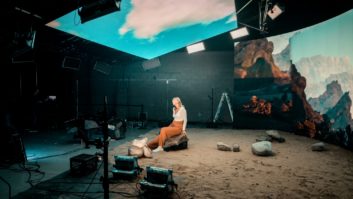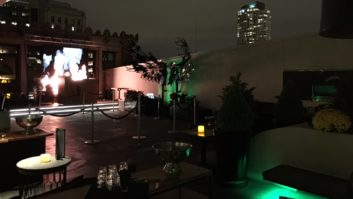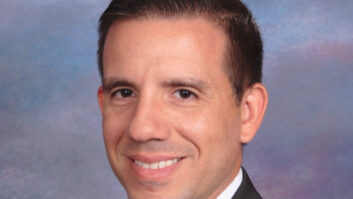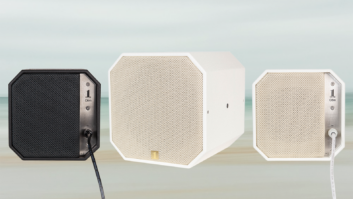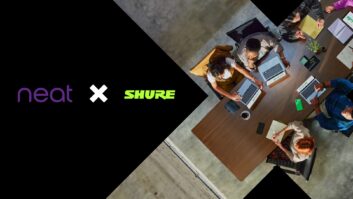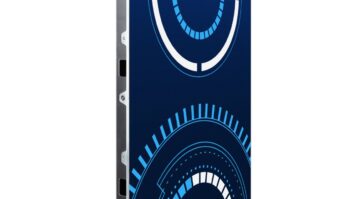The correct specification of audiovisual equipment for use outdoors is crucial. TFA looks at the world of IP ratings to help architects choose the right grade for the job in hand. There have been a high number of outdoor events cancelled this summer due to the weather. With the UK’s notoriously unpredictable climate prone to some very wet summers of late, what protection should architects be looking to provide for audiovisual equipment sited outdoors? It’s not enough to look for “weatherproof” or “waterproof” equipment. The IP Code (or Ingress Protection Rating, sometimes also described as International Protection Rating) consists of the letters IP followed by two digits or one digit and one letter and an optional letter. As defined in international standard IEC 60529, the IP Code classifies and rates the degrees of protection provided against the intrusion of solid objects (including body parts like hands and fingers), dust, accidental contact, and water in mechanical casings and with electrical enclosures. The standard aims to provide users more detailed information than vague marketing terms such as “waterproof”. The digits (characteristic numerals) indicate conformity with certain tested conditions. Where there is no protection rating with regard to one of the criteria, the digit is replaced with the letter X. The first digit indicates the level of protection that the enclosure provides against access to hazardous parts (eg electrical conductors, moving parts) and the ingress of solid foreign objects. No protection is rated zero, through to a rating of 6 for dust tight:
- 0 – No protection against contact and ingress of objects
- 1 – >50 mm – any large surface of the body, such as the back of a hand, but no protection against deliberate contact with a body part
- 2 – >12.5 mm – fingers or similar objects
- 3 – >2.5 mm – tools, thick wires, etc
- 4 – >1 mm – most wires, screws, etc
- 5 – dust protected. Ingress of dust is not entirely prevented, but it must not enter in sufficient quantity to interfere with the satisfactory operation of the equipment; complete protection against contact
- 6 – dust tight. No ingress of dust; complete protection against contact.@page_break@
The second digit denotes liquid ingress protection:
- 0 – Not protected
- 1 – dripping water. Dripping water (vertically falling drops) shall have no harmful effect.
- 2 – dripping water when tilted up to 15°. Vertically dripping water shall have no harmful effect when the enclosure is tilted at an angle up to 15° from its normal position.
- 3 – spraying water. Water falling as a spray at any angle up to 60° from the vertical shall have no harmful effect.
- 4 – splashing water. Water splashing against the enclosure from any direction shall have no harmful effect.
- 5 – water jets. Water projected by a nozzle (6.3mm) against enclosure from any direction shall have no harmful effects.
- 6 – powerful water jets. Water projected in powerful jets (12.5mm nozzle) against the enclosure from any direction shall have no harmful effects.
- 7- immersion up to 1 m. Ingress of water in harmful quantity shall not be possible when the enclosure is immersed in water under defined conditions of pressure and time (up to 1 m of submersion).
- 8- immersion beyond 1 m. The equipment is suitable for continuous immersion in water under conditions which shall be specified by the manufacturer. Normally, this will mean that the equipment is hermetically sealed. However, with certain types of equipment, it can mean that water can enter but only in such a manner that it produces no harmful effects.@page_break@
POLARaudio and Saville Audio Visual recently installed an In/Out Dinplayer and Australian Monitor Colum Speaker into the giraffe enclosure at Belfast Zoological Gardens. Belfast Zoological Gardens cover 55 acres and contains many different enclosures and special areas for all sorts of exotic animals. The giraffe enclosure is at the heart of the zoo and is home to not only giraffes, but is frequented by visiting swifts in the summer months. Zookeepers engaged Saville Audio Visual’s Belfast office to provide them with a “weatherproof” audio system. The system was to be employed to play bird song and encourage the visiting swifts to nest in the nest boxes fitted to the walls of the giraffe enclosure. Saville’s team came up with the solution of fitting an Australian Monitor CS420 IP66-rated weatherproof column speaker and an In/Out D-01 Dinplayer. The Dinplayer is an advanced audio device with solid state memory, which has been designed to automatically play warning messages, voice alerts and all types of audio files; this allowed the zoo to create musical scenery to encourage the birds to nest. The Dinplayer incorporates a 20W mono power amplifier, stereo MP3 player and standard DIN clamp housing, allowing it to be used with different automation systems including touch screens and industrial computers. The giraffes seem to be enjoying the music – two baby giraffes have been born in the enclosure since the installation and the zoo are hoping for a successful outcome with its swift breeding program. www.polaraudio.co.uk
